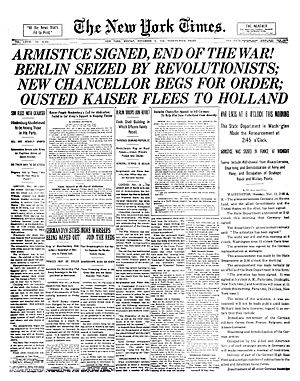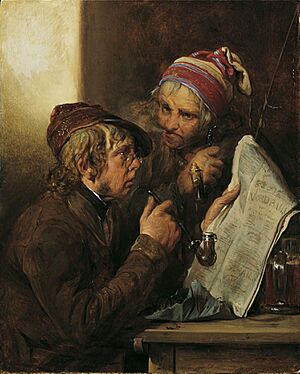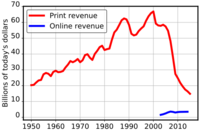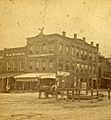Newspaper facts for kids
A newspaper is a special kind of publication that is printed on paper. It comes out regularly, usually every day or once a week. Newspapers share information and ideas about what's happening in the world and in your local area. They cover many different topics like politics, business, sports, art, and science. You can often find fun things in newspapers too, like opinion columns, weather forecasts, reviews of local places, crosswords, editorial cartoons, comic strips, and helpful advice columns.
Contents
What is a Newspaper?
Newspapers are usually printed every day or once a week. They share news stories and feature articles about what's happening both locally and around the world. This news can include political events, business and money news, important safety updates, weather, and even natural disasters. They also cover health, science, computers, sports, and entertainment like movies, food, fashion, and the arts.
Most newspapers divide their content into different sections. For example, you might find sections for news, sports, or entertainment. Many newspapers also have an "editorial page." This page features editorials, which are articles written by the newspaper's editors that share an opinion on a public topic. You might also find "op-eds" written by guest writers and columns where writers share their personal thoughts.
Most newspapers are businesses, but some are run or funded by the government. This means that what a newspaper chooses to publish can sometimes be influenced by its owners, advertisers, or the government. However, some newspapers are known for being very independent and having high-quality journalism. These are often called "newspapers of record."
Many newspapers hire their own journalists. They also often get news from news agencies like the Associated Press or Reuters. These agencies have journalists all over the world who gather news and then sell it to different newspapers. This helps newspapers share news from far away without having to send their own reporters everywhere. Around 2005, there were about 6,580 daily newspapers worldwide, selling 395 million copies every day!
What Makes a Newspaper a Newspaper?
Newspapers usually meet four main rules:
- Anyone can read it: The information in a newspaper is easy for the public to get. Traditionally, you could buy them at newsstands or shops, or find them in libraries. Since the 1990s, many newspapers are also available online on their online newspaper websites.
- Comes out regularly: They are published at steady times, usually every day or every week.
- Up-to-date news: The information in a newspaper is as current as possible for its publishing schedule. Online newspapers can be updated many times a day, so their news is very fresh.
- Covers many topics: Newspapers talk about a wide range of subjects, from politics and business to science, technology, art, and entertainment.
Newspaper History
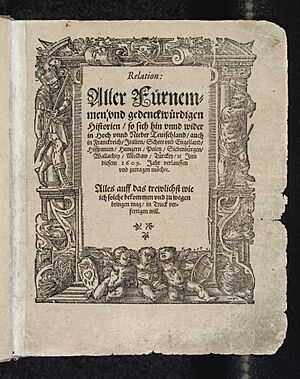
Long ago, in Ancient Rome, there were government announcements called Acta Diurna. These were carved into metal or stone and put up in public places. In China, early government news-sheets called Dibao were shared among officials around the 2nd and 3rd centuries AD. Later, from 713 to 734, China's Tang dynasty had the Kaiyuan Za Bao ("Bulletin of the Court"), which was handwritten on silk and read by government officials.
Newspapers as we know them started to develop in the 17th century. They began as information sheets for merchants. By the early 1800s, many cities in Europe, North America, and South America had their own newspapers.
In 1690, Benjamin Harris published Publick Occurrences Both Forreign and Domestick in Boston. This is thought to be the first newspaper in the American colonies, even though the government stopped it after only one issue. In 1704, the governor allowed The Boston News-Letter to be published, and it became the first newspaper in the colonies that was printed continuously. Soon after, weekly papers started in New York and Philadelphia. These early American newspapers were usually four pages long and mostly shared news from Britain. In 1783, the Pennsylvania Evening Post became the first American daily newspaper.
With the rise of the Internet, many newspapers are now digital. Their news is often read online, which has become the main way most people get their news. The printed version is sometimes secondary or, in some cases, no longer made. The idea that newspapers are "declining" is more complex than just print versus digital. Many newspapers now have a strong online presence, and people can subscribe to read them digitally.
Types of Newspapers
How Often They are Published
- A daily newspaper is printed every day, sometimes except for Sundays or Saturdays. Weekend editions are often bigger, have more special sections (like arts or entertainment), and cost more. Most of the newspaper staff works Monday to Friday, so weekend papers often use content prepared in advance. Most daily newspapers are sold in the morning.
- Some newspapers are published two times a week; these are called semi-weekly publications.
- A triweekly newspaper is published three times a week. The Meridian Star is an example of this.
- Weekly newspapers are published once a week and are usually smaller than daily papers.
- Some publications come out every two weeks, which is called fortnightly or biweekly.
Where They are Distributed
- A local newspaper serves a specific area, like a city or a part of a large city. Most areas have one or two newspapers that are most popular there.

- Most countries have at least one newspaper that is sold across the whole country. These are called national newspapers. Some national newspapers, like the Financial Times, focus on specific topics (like money news). The United Kingdom has many national newspapers, but the United States and Canada have fewer. In Canada, The Globe and Mail is sold everywhere. In the U.S., The New York Times is available across the country.
- There are also a few international newspapers. Some, like The New York Times International Edition, have always focused on global news. Others are national newspapers that are repackaged for an international audience.
What Topics They Cover
General newspapers cover all sorts of topics, but they might focus more on certain things. Some might have great coverage of important international events, while others might focus more on local entertainment or sports. Special newspapers might focus only on specific topics, like financial news. There are also publications that cover only sports, or even specific sports like horse-racing, but these might not always be called "newspapers" anymore.
Newspaper Formats

Most modern newspapers come in one of three sizes:
- Broadsheets: These are large, about 600 by 380 millimeters (23.5 by 15 inches). They are often linked with more serious newspapers. An example is The Daily Telegraph in the United Kingdom.
- Tabloids: These are half the size of broadsheets, about 380 by 300 millimeters (15 by 11.75 inches). They are sometimes seen as more focused on exciting or shocking stories. Examples include The Sun and the New York Post.
- Berliner or Midi: These are in-between sizes, about 470 by 315 millimeters (18.5 by 12.4 inches). European newspapers like Le Monde in France and El País in Spain use this size.
Newspapers are usually printed on cheap, off-white paper called newsprint. Since the 1980s, newspapers have moved from older, lower-quality printing to better, four-color offset printing. Also, computers, word processing software, graphics software, and digital cameras have changed how newspapers are made. These new technologies allow newspapers to print color photos and graphics, and create more interesting designs.
To stand out, some newspapers are printed on colored newsprint. For example, the Financial Times is printed on a unique salmon pink paper. The Italian sports newspaper La Gazzetta dello Sport is also pink, while L'Équipe is yellow.
How Many People Read Newspapers?
The number of copies of a newspaper that are sold or given out each day (or on specific days like Sunday) is called its circulation. This number is important because it helps set the prices for advertisements.
A common way to check how well a newspaper is doing is to look at its "market penetration." This is the percentage of homes in an area that get a copy of the newspaper. In the 1920s in the U.S., daily newspapers reached 123 percent of homes, meaning the average home got 1.23 newspapers. As other media like TV and the internet became popular, and printing became cheaper, more types of publications appeared, and newspaper readership started to go down.
-
Newspaper vendor, Paddington, London, February 2005
Newspaper Advertising
Newspapers usually get most of their money (about 70–80%) from advertising. The rest comes from selling copies and subscriptions. The parts of the newspaper that are not advertisements are called "editorial content" or simply "editorial."
In countries with easy access to the internet, newspapers have faced challenges because many traditional advertisers have moved their ads online. Big stores and supermarkets used to buy many pages of ads in newspapers. Now, they are less likely to do so, and many advertisers are shifting to social media and news websites.
Journalism and Newspapers
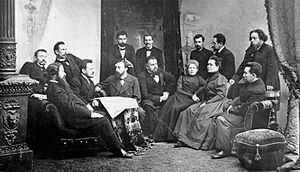
Since newspapers started as a way to record current events, the job of making newspapers became known as journalism. In the late 1800s, during the "yellow journalism" era in the United States, some newspapers focused on exciting or shocking stories to get people's attention, rather than just informing them. But around World War II, a more careful style of reporting, which focused on checking facts and being accurate, became popular again.
People sometimes criticize journalism for various reasons. They might question information from anonymous sources, point out mistakes in facts or grammar, or feel that a newspaper is biased. There have also been scandals involving plagiarism (copying someone else's work) and making up stories.
In the past, newspapers were often owned by powerful people who used them to share their political views. After 1920, many major newspapers became part of large companies called media corporations, like Gannett or Hearst Corporation. In the modern world, newspapers play a big role in freedom of expression. People who want to expose secrets or corruption, often called "whistle-blowers," sometimes choose to tell newspapers first. They trust that newspaper editors will be willing to reveal the truth. However, there have been times when newspapers' independence has been limited.
Readers' opinions are often shared in the "op-ed" (opposite the editorial page) and "letters to the editors" sections of the paper. To improve their trustworthiness, some newspapers have hired ombudsmen (people who investigate complaints), created rules for ethical reporting, and made sure to correct mistakes clearly.
Newspapers in the Digital Age
By the late 1990s, news became available 24 hours a day on TV and then online. This created a big challenge for how most newspapers made money in developed countries. Fewer people bought printed newspapers, and advertising money started moving from print to social media and news websites. This led to a general decline in newspaper revenue. One reason for this is that many online news websites are free to access. Other online news sites use a "paywall" and require a paid subscription to read their content. However, in less-developed countries, newspapers are still growing because printing and distribution are cheaper, more people can read, and the middle class is growing.
Newspaper Archives
In the internet age, digital archives (online collections) have been replacing older ways of storing newspapers, like microform (tiny film copies) and hard copy (paper copies). Old newspapers are now often scanned and turned into digital files using image scanning and optical character recognition (which turns images of text into searchable text).
Images for kids
-
The front page of the Helsingin Sanomat ("Helsinki Times") on July 7, 1904
-
International newspapers on sale in Paris, France
-
Soldiers in an East German tank unit reading about the erection of the Berlin Wall in 1961 in the newspaper Neues Deutschland
-
The newsroom of Gazeta Lubuska in Zielona Góra, Poland
-
The office building of Tyrvään Sanomat in Sastamala, Finland
See also
 In Spanish: Periódico para niños
In Spanish: Periódico para niños
- List of newspaper comic strips
- List of online newspaper archives
- Lists of newspapers
- Off stone
- Media studies



